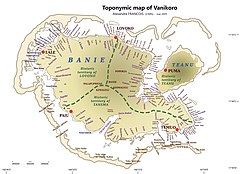Lovono language
| Lovono | |
|---|---|
| Alavana | |
| Native to | Solomon Islands |
| Region | Vanikoro |
Native speakers | 4 (2012)[1] |
| Language codes | |
| ISO 639-3 | vnk |
| Glottolog | vano1237 |
| ELP | Vano |
 Lovono is classified as Critically Endangered by the UNESCO Atlas of the World's Languages in Danger | |
Lovono (Vano, Alavano, Alavana) is a nearly extinct language of the island of Vanikoro in the easternmost province of the Solomon Islands. As of 2012, it is only spoken by four speakers;[1] it has been replaced by the island’s dominant language, Teanu.
Name
[edit]
The language name makes reference to an ancient village in the northwest of the island Banie.[3] In the language Lovono, which was once the dominant one in that area, the village was called Alavana. In Teanu, which is now the only language spoken by the modern population, the same village is called Lovono. This language shift is reflected in the people’s preference to use the Teanu form (i.e. Lovono) both for the village name and for the ancient language that used to be associated with it.
The same village – and hence the language – has been also spelled Whanou or Vano in the scientific literature, possibly reflecting an older pronunciation of the word.
The language
[edit]Some information on the languages of Vanikoro, including Lovono, can be found in François (2009) for the grammar, and François (2021) for the lexicon.[4]
Notes
[edit]- ^ a b Homepage of the linguist A. François.
- ^ Source: Maps of Vanikoro (languages, place names).
- ^ François (2009).
- ^ See also François (2022) for a general presentation.
References
[edit]- François, Alexandre (2009), "The languages of Vanikoro: Three lexicons and one grammar" (PDF), in Evans, Bethwyn (ed.), Discovering history through language: Papers in honour of Malcolm Ross, Pacific Linguistics 605, Canberra: Australian National University, pp. 103–126
- —— (2021). Online Teanu–English dictionary, with lexical data in Lovono and Tanema. Paris, CNRS.
- —— (2022). "Presentation of the Lovono language, and audio archive". Pangloss Collection. Paris: CNRS. Retrieved 26 September 2022.
External links
[edit]- Audio recordings in the Lovono language, in open access, by A. François (source: Pangloss Collection of CNRS).
